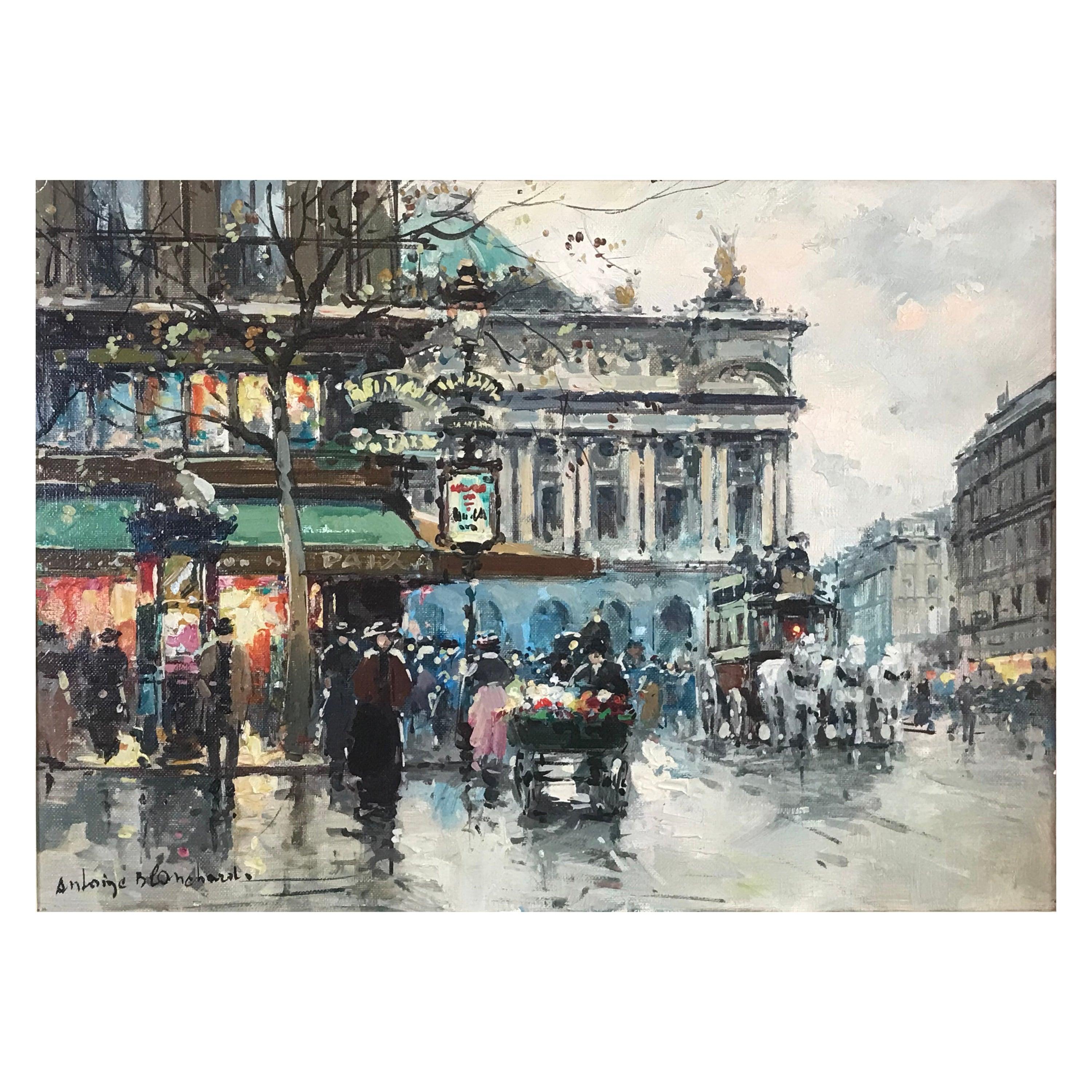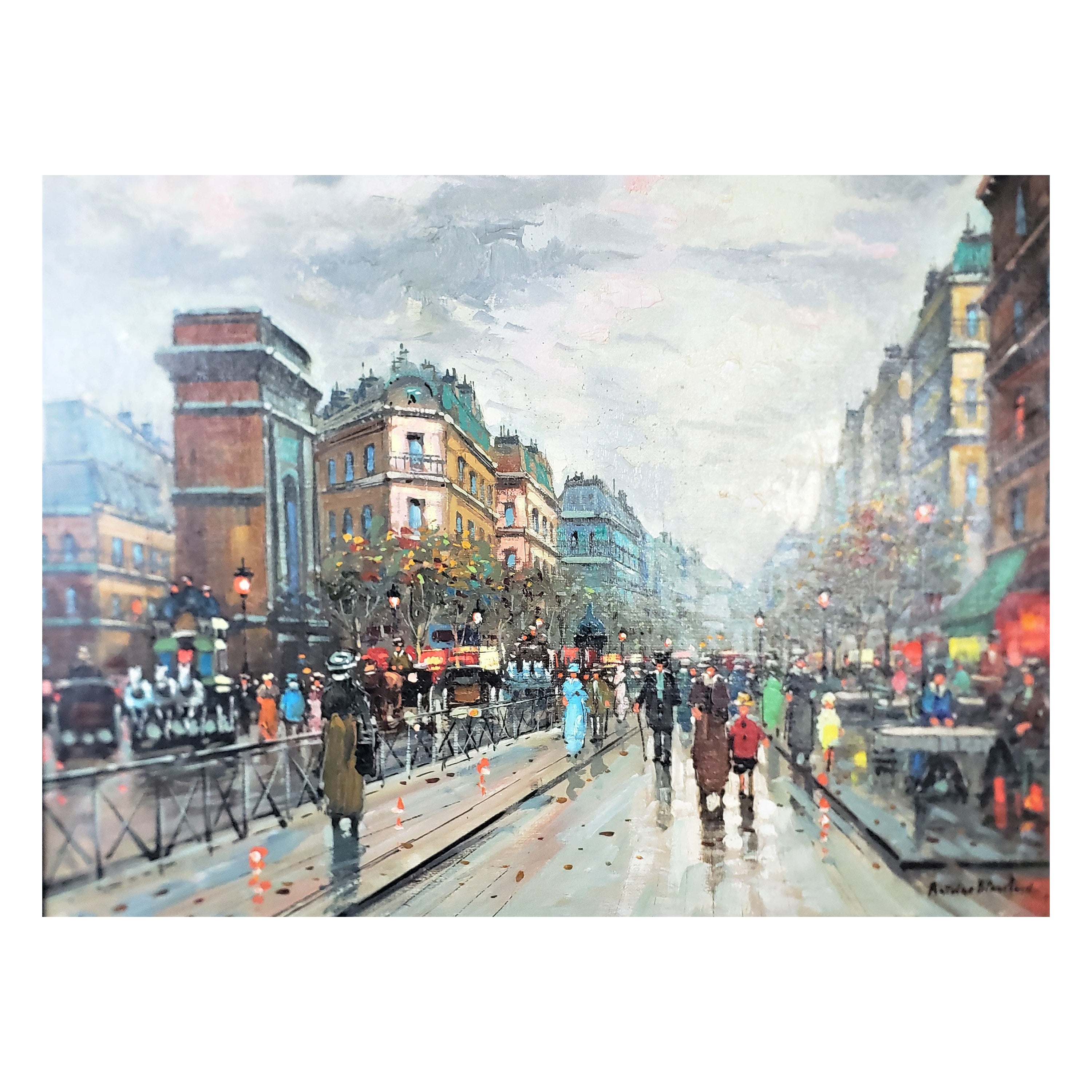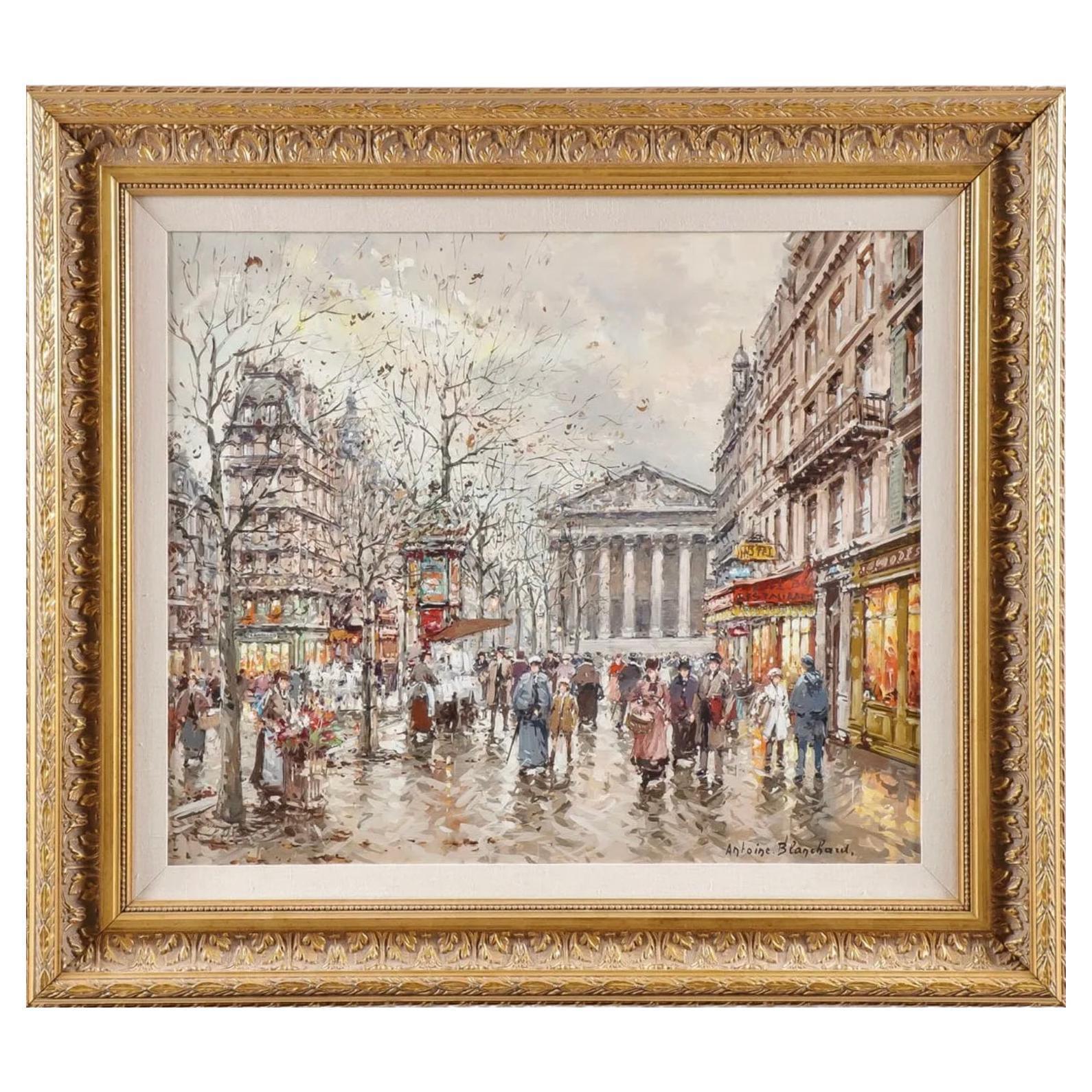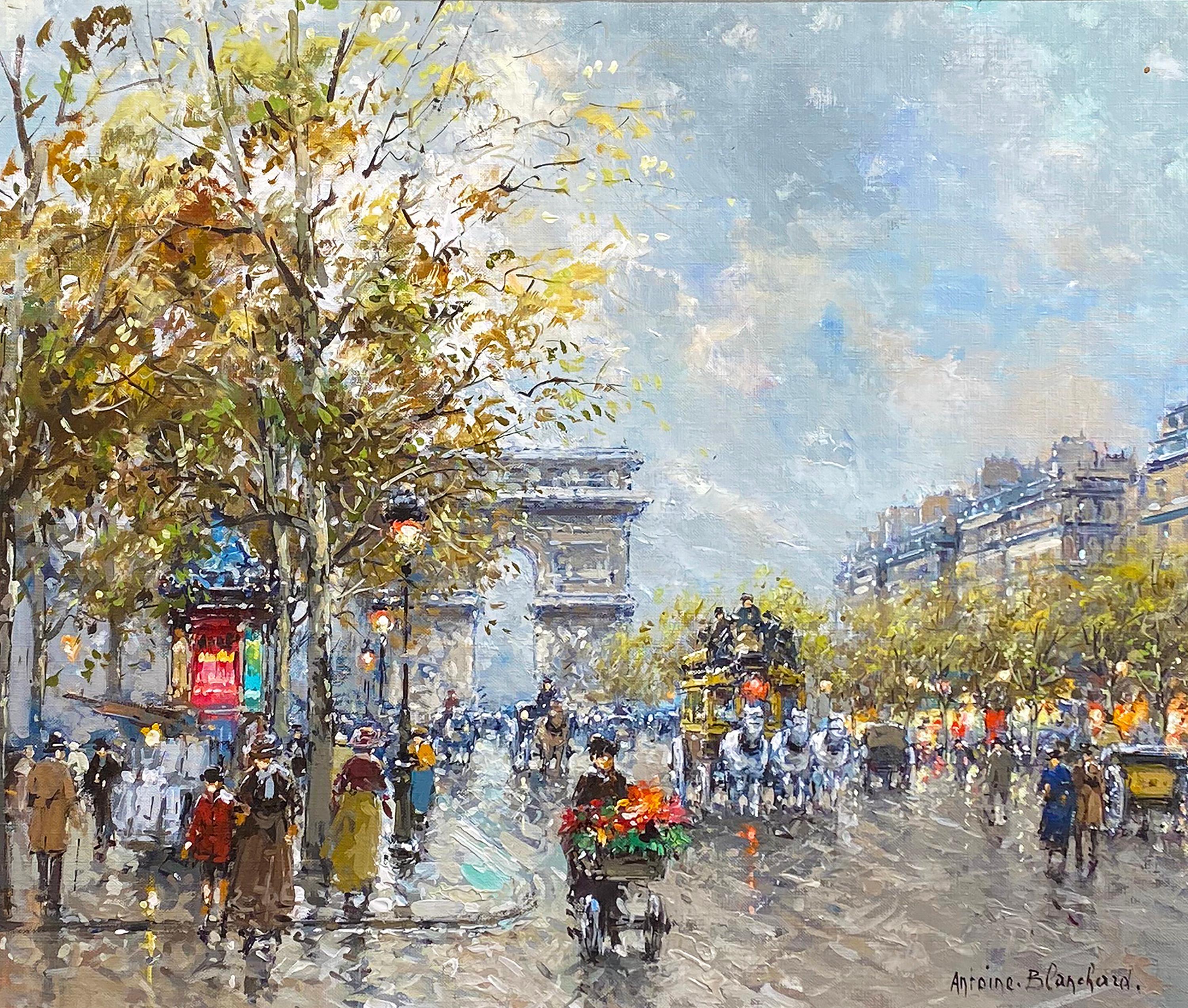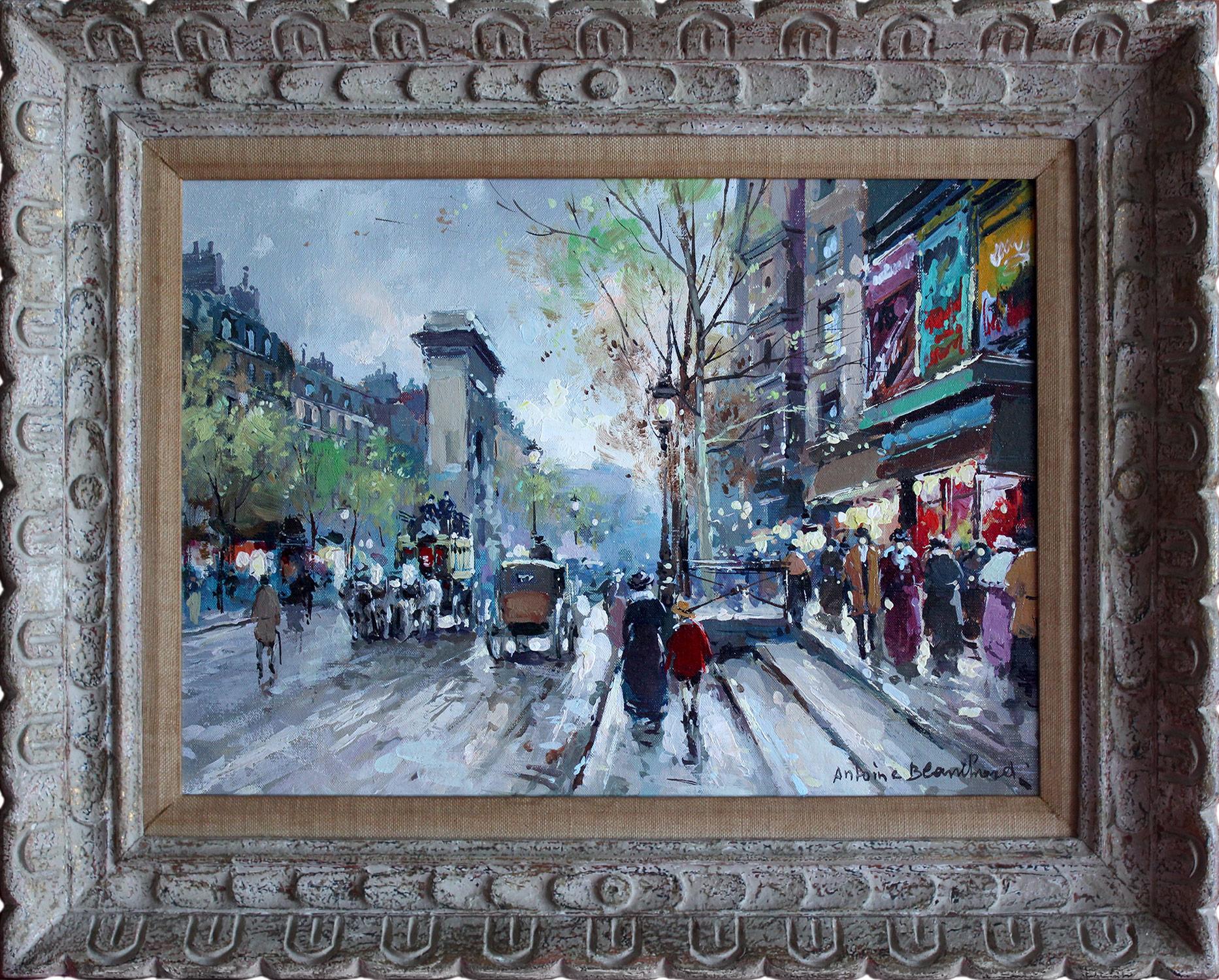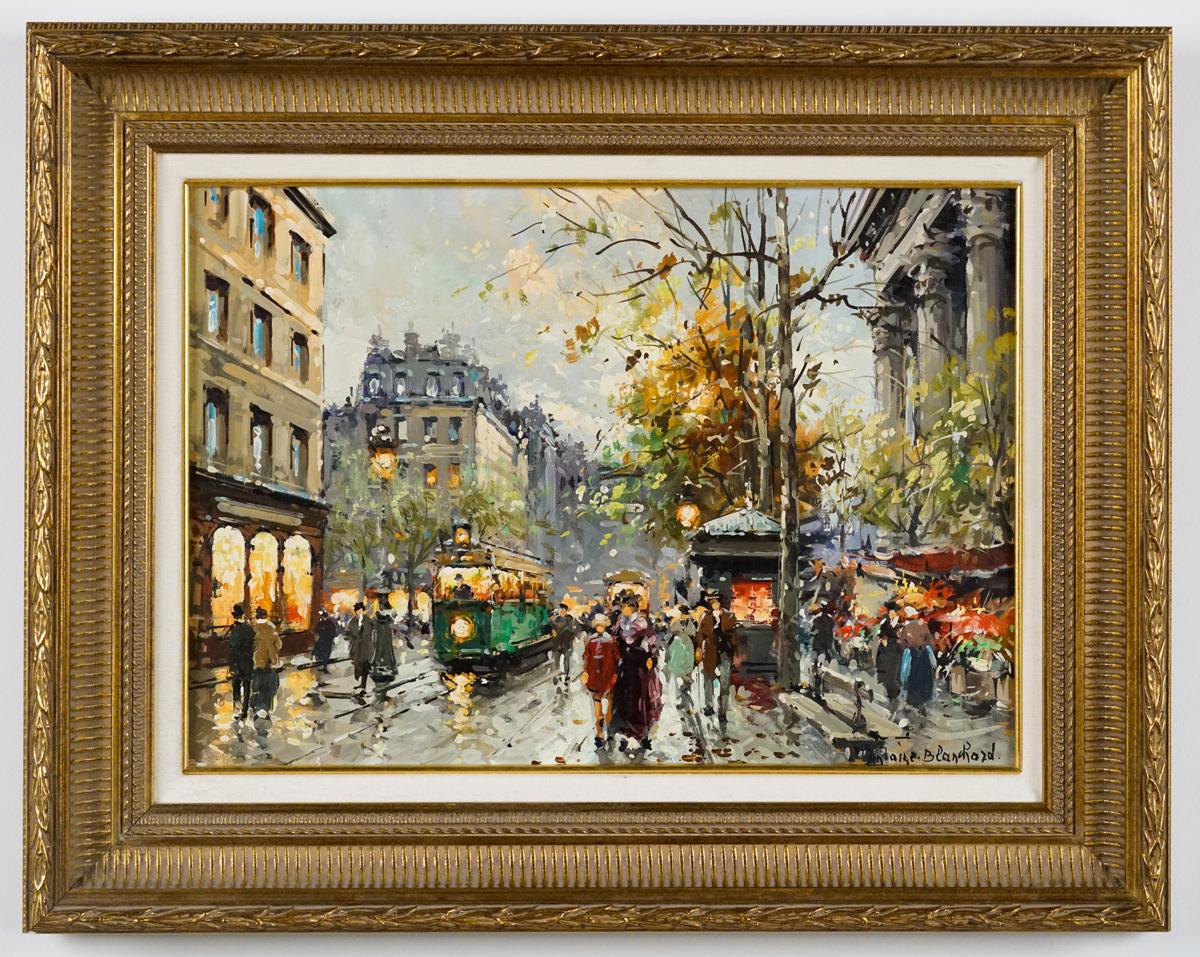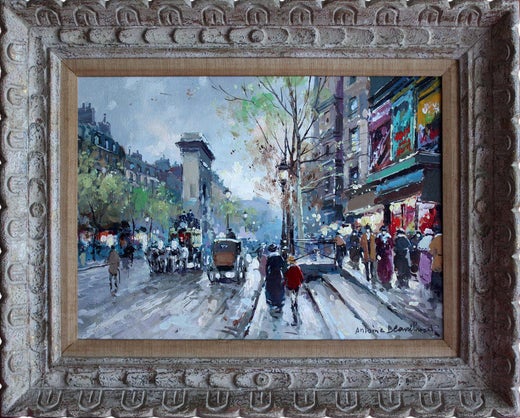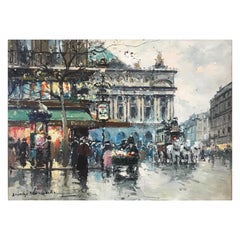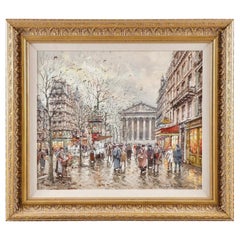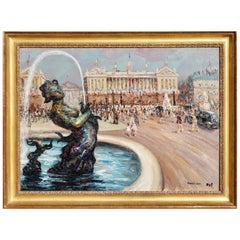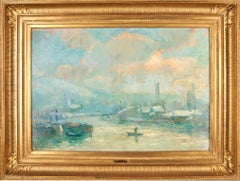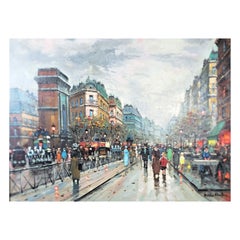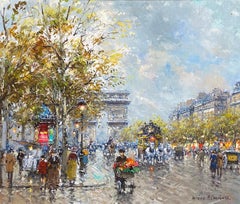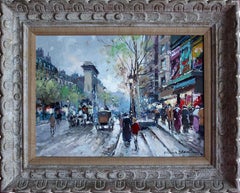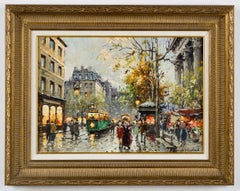Items Similar to Antoine Blanchard Boulevard De Capucines, Place De La Madeleine
Want more images or videos?
Request additional images or videos from the seller
1 of 12
Antoine BlanchardAntoine Blanchard Boulevard De Capucines, Place De La Madeleine1956
1956
$7,400
£5,587.69
€6,482.86
CA$10,399.32
A$11,586.32
CHF 6,048.60
MX$140,673.31
NOK 76,027.02
SEK 71,864
DKK 48,393.80
About the Item
Antoine Blanchard (1910 - 1988) Boulevard Des Capucines, Place De La Madeleine. A wonderful and vibrant scene from the Grand Boulevards of Paris under the rain in fall. You can hear the horses prancing and carriages on the cobblestone streets. You can smell the fresh croissants and beufe bourguignon simmering in the nearby restaurant. The feeling of Fall, fashion and Paris is in the air.
Oil on canvas
Canvas: 13x 18 inches
Framed: 19.5 x 24.5 Inches
Signed “Antoine Blanchard” LL
Condition: Excellent with period frame with wear.
AVANTIQUES is dedicated to providing an exclusive curated collection of Fine Arts, Paintings, Bronzes, Asian treasures, Art Glass and Antiques. Our inventory represents time-tested investment quality items with everlasting decorative beauty. We look forward to your business and appreciate any reasonable offers. All of our curated items are vetted and guaranteed authentic and as described. Avantiques only deals in original antiques and never reproductions. We stand behind our treasures with a full money back return policy if the items are not as described.
Please also consider Avantique’s eclectic collection of wonderful fine art paintings with artists such as Anthony Thieme, Emile Albert Gruppe, Alphonse Mucha, Maximilien Luce, Alfred De Breanski, Antoine Blanchard, and Marcel Dyf. We strive to collect the highest-quality paintings in exceptional condition.
Antoine Blanchard was born in France on November 15, 1910 in a small village near the banks of the Loire. He was the eldest of three children and his father, a carver, managed a small carpentry and furniture shop. Antoine would watch his father hand carve the furniture and began to display an artistic flair early in life - in an effort to promote this talent, his parents sent him to Blois for drawing lessons. He continued his training in Rennes at the Ecole des Beaux-Arts where he studied sculpture and drawing. Upon completion of his studies, he was awarded the schools highest award: Le Prix du Ministre.
By 1932 he left Rennes and traveled to Paris to study. He enrolled at the Ecole des Beaux-Arts and after a few years entered the competition for the Prix de Rome. It was in Paris that he developed a love for the city and it's street life.
In 1939 Antoine married a young woman he met in Paris and in September of that year war broke out and he was called up for service. It was not until 1942 that he would return to his art. His daughter Nicole was born in 1944 - she too would follow in the family tradition and after the birth of her two daughters, she became an artist working under the name A. Champeau. It was also around this time that Antoine's father passed away and he was compelled to return to his hometown and run the family business - giving him little time to paint.
His second daughter, Evelyn, was born in 1947 and by 1948 he had given control of the family business to his younger brother and returned to Paris to paint. Contemporary life in Paris had changed and he longed for the bygone days. He began to research the Belle Époque period in Paris - reading and studying all the material on the period he could find.
Many of the subjects and scenes he portrayed were taken from images he collected of Paris during the 1890's and he would often work on paintings for days or months before he finally felt they were complete. A.P. Larde comments in his book Antoine Blanchard, His Life His Work that he has always spent much time on his work. This explains why his production has always been rather limited, unlike the hurried and multiple proliferations of some modern artists… Delicate touches of luminous and shimmering tones produce a marvelous impression of harmony, brightness and light. Alternate shadings and lights, sensitive and mellow blending allow the artist to attain a hardly-ever reached degree of grace, of radiant and glimmering freshness.
Larde continues to write that his works are first of all, a marvelous invitation to an ideal walk through old Paris, so different from that of to-day. Although a large number of historical monuments remain, today's Paris has little in common with Paris at the turn of the century; the scenery may be almost the same, but daily life as it characters has totally changed; the customs have been entirely transformed. In his paintings, Antoine Blanchard invites us to relive this period by showing us pleasant strolls along embankments, squares and boulevards at a period in Parisian life when time did not count, when one had all one's time to idle, to stroll along the streets, to window-shop, to walk quietly along the boulevards or spend the afternoon in a sidewalk café.
Like his contemporary, Édouard Cortès, he devoted his artistic career to the depiction of Paris through all its daily and seasonal changes. But he was not an imitator of Cortes, but rather depicted the life of Paris at the turn of the century from his own point of view and with his own, unique style. Larde makes an interesting comparison:
Édouard Cortès has always expressed himself in a rather rich virile style, using large and stressed touches, revealing a strength, which recalls the great masters of the XVIIIth century.
On the contrary, Antoine Blanchard has always used small strokes, with a delicate, enveloping and mellow treatment; the slight haziness which is a characteristic of his work in many ways recalls the great masters of the impressionist period.
Whether it was l'Arc de Triomphe, la Madeleine, Café de la Paix, Notre Dame or the dozens of other historical monuments and buildings of Paris, his focus was on the daily life of Paris at the turn of the century. His work became highly sought after and collectors from around the world vied to acquire his new works. Today he is considered one of the leading exponents of the School of Paris painters.
- Creator:Antoine Blanchard (1910-1988, French)
- Creation Year:1956
- Dimensions:Height: 19.5 in (49.53 cm)Width: 24.5 in (62.23 cm)Depth: 2 in (5.08 cm)
- Medium:
- Period:
- Condition:
- Gallery Location:Dallas, TX
- Reference Number:1stDibs: LU2724214289002
Antoine Blanchard
Antoine Blanchard (1910-1988) was a French oil painter renowned for his impressionist cityscapes of beautiful Paris.
About the Seller
No Reviews Yet
Vetted Professional Seller
Every seller passes strict standards for authenticity and reliability
1stDibs seller since 2024
9 sales on 1stDibs
Typical response time: 1 hour
- ShippingRetrieving quote...Shipping from: Dallas, TX
- Return Policy
Authenticity Guarantee
In the unlikely event there’s an issue with an item’s authenticity, contact us within 1 year for a full refund. DetailsMoney-Back Guarantee
If your item is not as described, is damaged in transit, or does not arrive, contact us within 7 days for a full refund. Details24-Hour Cancellation
You have a 24-hour grace period in which to reconsider your purchase, with no questions asked.Vetted Professional Sellers
Our world-class sellers must adhere to strict standards for service and quality, maintaining the integrity of our listings.Price-Match Guarantee
If you find that a seller listed the same item for a lower price elsewhere, we’ll match it.Trusted Global Delivery
Our best-in-class carrier network provides specialized shipping options worldwide, including custom delivery.More From This Seller
View AllAntoine Blanchard Cafe De La Paix
Located in Dallas, TX
Antoine Blanchard (1910 - 1988) Cafe de la Paix. Circa 1950 wonderful and vibrant scene from the Grand Boulevards of Paris under the rain in fall. You can hear the horses prancing an...
Category
1950s Landscape Paintings
Materials
Paint
Antoine Blanchard La Madeleine Et La Rue Tronchet 18x21
By Antoine Blanchard
Located in Dallas, TX
ANTOINE BLANCHARD (French 1910 - 1988)
La Rue Tronchet et la Madeleine
Oil on canvas
Circa 1980
Signed lower right and signed and titled on verso
18 x 21.5 inches (47 x 54.5cm)
...
Category
1980s Aesthetic Movement Paintings
Materials
Paint
Marcel Dyf “Place De la Concorde”
By Marcel Dyf
Located in Dallas, TX
Marcel Dyf
French, 1899-1985
“Place de La Concorde” , 1948
Signed Dyf and dated 1948 Paris (lr)
Oil on canvas
Canvas: 29 x 39.75 Inches (73.6 x 99 cm)
Framed: 35 x 45.25 Inches
...
Category
1940s Landscape Paintings
Materials
Paint
Albert Lebourg: Rouen: La Seine, La Côte Sainte-Catherine, et
By Albert Lebourg
Located in Dallas, TX
Albert Lebourg (French, 1849-1928)
Rouen: La Seine, La Côte Sainte-Catherine, et L'Ile Lacroix, en Hiver
signed 'A. Lebourg' (lower left); attributed on a presentation plaque; with t...
Category
1910s Impressionist Landscape Paintings
Materials
Canvas, Oil
Eugene Galien Laloue Large Landscape Oil painting
By Eugene Galien-Laloue
Located in Dallas, TX
Eugene Galien Laloue (French, 1854-1941) Large oils on canvas landscape painting of the outskirts of Paris on the Seine River with figures and bui...
Category
1880s Landscape Paintings
Materials
Paint
Henri-Joseph Harpignies (French, 1819) L’Ete Dans La Saint Martin
By Henri Joseph Harpignies
Located in Dallas, TX
Henri-Joseph Harpignies (French, 1819)
Paysage D' Ete de la Saint-Martin
Oil on canvas
Portraying a landscape scene in summer outside of Paris on a subsidiary of the Seine River o...
Category
Early 1900s Barbizon School Paintings
Materials
Paint
You May Also Like
Antoine Blanchard Original Antique Parisian Street Scene Oil Painting on Canvas
By Antoine Blanchard
Located in Hamilton, Ontario
This large antique origina painting was done by well known Anoine Blanchard of France in approximately 1920 in his signature Impressionistic style. The painting is done with oil pain...
Category
Early 20th Century French Art Deco Paintings
Materials
Canvas
Avenue des Champs-Elysses, Paris
By Antoine Blanchard
Located in Missouri, MO
Antoine Blanchard (French 1910-1988)
"Avenue des Champs-Elysses, Paris"
Oil on Canvas
Signed
approx 18 x 22 (site)
approx 26.5 x 30 (framed)
Antoine Blanchard (c.1910-1988) was a prolific and successful Neo-Impressionist painter who specialized in nostalgic scenes of Fin de Siècle Paris. Inspired by the subjects as well as the success of earlier painters of Parisian life like E. Galien Laloue (1854-1941), Edouard Cortès (1882-1969), Jean Béraud (1849-1935) and Luigi Loir (1845-1916), Blanchard painted hundreds of views of the “City of Light.” In the late 1950s, his street scenes were exported to the United States and the United Kingdom, where they were sold briskly to collectors. By the1960s, Blanchard paintings were bringing several hundred dollars in galleries, so while they were not inexpensive, they were affordable to collectors who loved Parisian scenes but who could not afford the works of Cortes or one of the other French painters known for their views of Paris in Belle Époque. Eventually Blanchard’s more delicate, feathery pastel-toned scenes of rain-swept Paris became sought after in their own right and, when he died, he was considered the last of what the dealers described as the École de Paris or “School of Paris” painters.
The most salient fact about the life and career of the painter Antoine Blanchard was that he was actually born Marcel Masson, the son of a furniture maker who lived in the scenic Loire Valley, south of Paris, where the French nobility had their chateaus. The date that is usually given for Blanchard’s birth is November 15, 1910. However, there has been some speculation that he was born even later, perhaps in 1918, but some of the facts of his life have always been clouded by early biographies that claimed even earlier dates for his birth, so that he would seem to be seen as a contemporary of the famous Belle Époque painters rather than a post-war interpreter of Paris.
Blanchard grew up in the hardscrabble years following the First World War. Because he was artistically talented, he was sent first to the nearby city of Blois, the capital of the Loir-et-Cher Département, for artistic training and then to the École des Beaux-Arts in Rennes, on the Brittany peninsula, where he received a classical art education. By some accounts Blanchard also studied in Paris, where the historic École des Beaux-Arts is located, but the depth of his study and the style of his earliest work will require further research.
Marcel Masson was married in 1939, as war clouds gathered on the French horizon. He was drafted for service in the French Army and participated in the short and futile struggle against the invading German Panzers before returning to his family and his art during the Nazi occupation. A daughter, Nicole, was born in 1944 with a second daughter, Eveline, who eventually came to the United States, following in 1946.
Masson’s early art career was interrupted, first by World War II and later by the necessity of keeping his father’s workshop running in the years after his death. By the late 1940s, though, Masson returned to his art and moved to Paris in order to further his career.
Exactly when Marcel Masson adopted the pseudonym Antoine Blanchard is not known, nor are we aware of his motivations for adopting a nom de plume, but the practice was not unusual for French painters. In most cases a pseudonym was adopted because the artist had contractual obligations with more than one agent or dealer. Another motivation could be to obscure the scope of a sizable artistic production. Dealers in that era also liked to keep an artist under their thumb, so a pseudonym was a way for Blanchard’s dealers to tuck him away, out of the sight of their competitors.
Like many painters before him Masson may have initially painted different subjects under different names. Marcel Masson neé Blanchard would have been well aware that the famous and prolific French painter E. Galien Laloue (1854-1941) painted under no less than four names – three pseudonyms in addition to name he was christened with – and so the adoption of another name was probably not seen as a liability to him.
However, he apparently never took the step to register his pseudonym, which was possible in France, to legally restrict its use. In any event, by the 1950s Marcel Masson had become “Antoine Blanchard,” a painter of Parisian views. With the aging Edouard Cortès (1882-1969) as a model, Blanchard began to specialize in romanticized scenes of la ville des lumières, or the “City of Light.”
However, instead of painting contemporary Paris, the crowded metropolis of his own time, which he may have felt was lacking in romance, he chose to look at the French capital through the rear-view mirror. So Blanchard became known for his depictions of the hurly-burly life of Paris in the Belle Époque. For inspiration, he is said to have collected old sepia-toned postcards of life in La Belle Époque (“The Beautiul Era”), the long period of peace and relative prosperity between the end of the Franco-Prussian War and the horrors of the Paris Commune in 1871 and the start of the mass bloodshed of the First World War in August of 1914. In addition, however, the paintings of Loir, Baraud, Laloue and Cortès could be found and studied in the flea markets of Paris as well as the auctions at the l’Hôtel Drouot.
Reminders of the Belle Epoch were thus all around Blanchard, and of course the architecture that he painted had survived the Second World War intact, because Paris was spared bombing or a siege by the allies. Soon he was painting the horse-drawn omnibuses that took turn-of-the-century Parisians on longer trips throughout the city as well as the tradesmen, children and fashionably dressed ladies that populated Baron Haussmann’s Grand Boulevards.
Blanchard’s early work was clearly modeled after the paintings of Edouard Cortès, but he was always his own man and never a slavish copyist. These paintings were darker in palette than the later Blanchard paintings most American collectors have become familiar with, and his red and blue tones were often bolder than those of Cortès. He never adopted the heavy “impasto,” the build-up of paint on the highlights of Cortes’ work, leaving that artistic trademark to the master. Blanchard’s brushwork was painterly, but the buildings in the paintings were always well rendered, for he had an excellent command of composition and perspective.
By the late 1950s, agents began to purchase Blanchard’s paintings and then to export them to the United States, selling them to commercial galleries in far away Houston, Los Angeles, San Francisco, Chicago and New York. By the early 1960s, his work was already well known enough to be in reproduced by print publishers and the Donald Art Company published a number of popular prints that are now often mistaken for original paintings. By the end of the 1960s, Blanchard had begun to develop his own mature style by employing a lighter, brighter, palette and a deft, almost calligraphic style of brushwork. This helped him step out of Cortès’ shadow and become a sought-after painter in his own right. Blanchard worked through agents, essentially brokers, who purchased his work and created a demand for it in the United States and Canada.
By the 1970s Blanchard’s paintings were being sold by galleries across the United States, and the American market absorbed virtually all of his work. In 1969, with the passing of Edouard Cortès, he became the last of the long series of prolific French painters of Parisian life. Blanchard’s later works were usually daylight scenes, with Paris seen awash in rain or with a mantle of soft snow, and so collectors no longer confused him with Cortes, whose Parisian clock seemed to always be set at twilight. These paintings were rendered in softer, pastel tones and he used his brush with a light touch. These qualities gave Blanchard’s work of the 1970s and 1980s a lighter, more decorative appearance.
In the late 1970s, the French agent Paul Larde published a lavish book that was claimed to be an authorized biography of Antoine Blanchard by his “exclusive” dealer. Today, this book is almost impossible to find, because it was apparently the subject of a lawsuit in France. Some of the information in the Larde book was contested and found to be inaccurate and so it was withdrawn from publication.
One claim that Larde made was that Blanchard’s production was extremely limited. While he was not as prolific as Cortès or Laloue, he was a hard-working painter who managed to supply a long list of galleries with his work. He produced thousands of paintings during his career. When the motivation for a monograph is marketing rather than art history, accuracy and detail can be swept aside by exaggeration, hyperbole and claims of exclusivity that were meant to discourage collectors or galleries from buying Blanchard’s from other representatives. Blanchard’s legitimate paintings were sold by several agents, who dealt directly with the artist, at least one of whom was American, one Austrian and a few French dealers.
The details of Antoine Blanchard’s life are not well known because he never sought the limelight. He was content to work in his studio and ship his paintings to his agents who sold them abroad. Eventually both his daughters – Nicole and Evelyn – followed in his footsteps and became painters themselves. Evelyn (1946-2008) was savvy enough to adopt the Blanchard nom de plume, and she began painting street scenes that closely resembled her father’s later work.
Antoine Blanchard passed away in 1988, leaving hundreds of paintings of Belle Époque Paris– the Notre Dame Cathedral, the Opera, the Arc de Triomphe and Place Concorde – as his lasting legacy.
Notes on the Authentication of Antoine Blanchard’s Paintings:
The vast majority of Blanchard’s paintings were smaller works, which were sent to the United States in tubes and stretched and framed by the galleries that sold them. Virtually all of these Blanchards were painted in European centimeter sizes, which convert to 13” x 18” or 18” x 21 1/2?, but on very rare occasions he painted much larger works in American sizes – such as 24” x 36” – on commission for dealers such as Howard Morseburg in Los Angeles or the dapper Wally Findlay, who had a chain of galleries. The first way to assess the authenticity of a Blanchard...
Category
Mid-20th Century Impressionist Landscape Paintings
Materials
Canvas, Oil
Price Upon Request
Les Grands Boulevards et La Porte Saint Denis
By Antoine Blanchard
Located in New York, NY
An exquisite oil painting by renown artist Antoine Blanchards depicting the French street scene Les Grands Boulevards et La Porte Saint Denis. Th...
Category
20th Century Impressionist Landscape Paintings
Materials
Canvas, Oil
Flower Market, La Madeleine, Paris
By Antoine Blanchard
Located in Sheffield, MA
Antoine Blanchard
French, 1910-1988
Flower Market, La Madeleine, Paris
Oil on canvas
13 by 18 in. W/frame 19 by 24 in.
Signed lower right
Provenance:
Catalda Fine Arts, Inc., New York
Private Collection, New York
Trinity House Paintings, London
Private Collcetion, New York
Alexander Avenard Collection
Le Trianon...
Category
Mid-20th Century Post-Impressionist Landscape Paintings
Materials
Oil
Quai de Louvre
By Antoine Blanchard
Located in Missouri, MO
Antoine Blanchard
"Quai de Louvre"
Oil on Canvas
Signed
Canvas Size: approx 13 x 18
Framed Size: approx. 22 x 26
Category
Mid-20th Century Post-Impressionist Landscape Paintings
Materials
Canvas, Oil
Price Upon Request
Champs-Elysees
By Antoine Blanchard
Located in Belgravia, London, London
Oil on canvas
Canvas size: 13 x 18 inches
Framed size: 20.5 x 25.5 inches
Signed lower right
Category
20th Century Impressionist Figurative Paintings
Materials
Canvas, Oil
More Ways To Browse
French Painting Boulevard
Rome Watch
Antique Parisian Painting
Vintage Madeleine Paris
Bronze Horse Painted
1948 Watches
Paris Street Scene Painting Large Canvas Painting
Paintings By Cortes
Watch 1942
Paris With Horse And Carriage
Blanchard Oil
Emile A Gruppe
Prancing Horse
Vintage Arc De Triomphe
Edouard Cortes
Edouard Cortes Oil Painting
Vintage Watch 1948
Dyf Marcel
